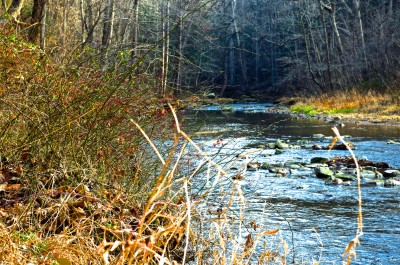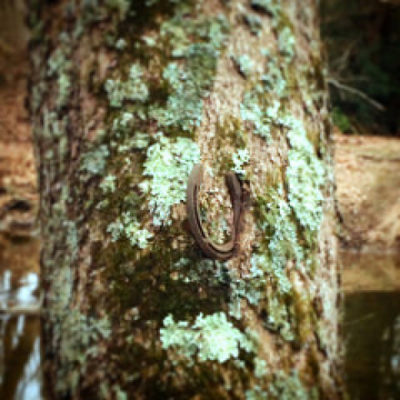You find yourself on the outskirts of town. Turn onto Huffmanville Road, just across the street from the Rutter’s gas station, and follow it for a couple miles. Along the tree line and over the farmland, houses and cars become more and more sporadic. Eventually, you’ll come to a small bridge. Out this far there are few signs of human development. Aside from the artful graffiti below the bridge, there is no evidence that anyone still passes through. There is only you. A path, slightly overgrown with shrubs, leads you down to the water’s edge. Follow the rippling stream. As you move further away from the bridge and into the gorge, the forest becomes denser and the trees grow larger. The forest canopy grows thick with oak leaves and hemlock needles. Further down the path, the air begins to smell cleaner and taste fresher, and a sense of peace envelopes you. Soon, you come to a small crossing. A small creek, only four feet wide, intersects with your path. A set of large rocks, set down by some nameless traveler, can be used to fjord the tiny creek. Be nimble, however, or risk a wet shoe or two for the remainder of your trek. The path curves to the right, and as you come around the bend the path and stream separate as the path heads up to a rocky ledge overlooking the stream far below. The path to the cliff is blocked by a fallen hemlock tree, evidence of a heavy storm from several years ago.
Just past the fallen hemlock, an old rope swing hangs from a tree overlooking the stream. Down below, the water is crystal clear and during a hot summer day it would be very refreshing. The flowing stream gives way to small, cascading waterfalls over rocks that have been smoothed away over time. Sunlight pokes through the canopy of trees and sparkles as it reflects off the water. The view is indeed picturesque, but you can’t stay forever. There are more sights to see and more of nature to explore.
You begin your descent from atop the rocky outcropping with the rope swing. Soon, the path leads you back along the stream’s edge and the trees give way to a field of tall grasses and shrubs. What causes this forest succession? Is it from logging or forest fire? Maybe the soil isn’t suitable for trees’ roots to grow. Once again, your path is intersected by a small flow of water trying to join up with the larger stream. This time, there is no stone path to help you cross. Now, you must put faith in yourself, take a running start if you need, and leap across the creek to the other side. You make it across in one jump, but the test is not over. You must now traverse a steep climb up the muddy bank before you can rest easy.
On top of the bank, something is out of place. A horseshoe, slowly being swallowed up by a tree, was certainly not put there by natural circumstance. Why is it there? How long has the tree been growing around it? It’s hard to say for sure. Like the crossing stones and rope swing, it’s one of the gorge’s many mysteries. An island is in sight, just past the horseshoe tree. You swiftly jump across the water’s gap and head to the far end of the small island to get a view of what’s to come. It occurs to you that you’ve run out of land. You’ve reached the end of your journey but the stream has not. You sit there and watch as the water disappears around the bend. The water will inevitably end up in the Chesapeake Bay, but what sights does it see from the moment the streams flows out of our sight to when it reaches its final destination? I cannot say. I’ve only ever traveled as far as the edge of the island. That’s as far as I’ve ever needed to travel in order to feel connected with this magical place.
I’ve spent a lot of time following the same path up and down the gorge over the years. When I close my eyes I can visualize the whole journey up and back, from start to finish. There are, of course, other paths to take, but I keep coming back to this one. No matter how many times I’ve visited this place, what I take away from my visits is always different and always positive. There’s something about this place and about nature that helps me reconnect with myself. I think it’s important to have a place in nature that you can call “yours.” No, I don’t mean that you own it or that only you can visit this place. I mean a place that holds deep meaning for you, a place that your mind always goes to in those moments where you need an escape.
People are connected to nature, whether they know it or not. From children to adults, we are all positively affected by nature. Even just taking a walk, listening to your surroundings, or climbing a tree can almost instantly turn a bad day into a good day. Spending time in nature can often be an alternative to medication for people with disorders such as ADHD and depression. It is unclear why nature has these effects on us, but what is clear is how beneficial it is for us.
It truly is amazing the impact that nature can have on the human condition. Especially at an early age, connecting with the outdoors is an integral part in one’s development. At 5 years old, a child doesn’t see just a tree. They see it as a towering fortress, a beanstalk, or just something to climb on. That vision and that freedom to explore help children to grow and to think creatively. It helps them to develop investigative, problem-solving, and technical skills. The earlier a child can be immersed in what the outdoors has to offer the better off they will be. Nature is the most organic form of learning there and it has lots of skills to teach us.
Aside from helping people to become more well-rounded and creative thinkers, nature is great for increasing positive emotions as well. As I said earlier, Hemlock Gorge was my place that I could go to when I was feeling down. Though I’d stay for a couple hours, it took no more than 15 minutes before I felt renewed and rejuvenated. But people don’t need a specific place to go in order to feel better. Taking a walk, fishing at a local pond or river, or even just laying out in your yard are some other ways that can help to improve your mood. Nature is considered by some to be an alternative to medication, and I certainly adhere to that belief. Through research, nature has been shown to have the same impact on mood that antidepressants do. But don’t take science’s word for it; take mine. For nearly two years I suffered from depression. I saw a therapist and I took medication. Those practices kept me from feeling any lower, but I still wasn’t my old self. Through a couple of misadventures I discovered Hemlock Gorge, and it changed my life.
I started visiting once a week because I enjoyed what the view had to offer. My mood started improving with each visit. I didn’t know it at the time, but I was building my connection with nature. I started participating in life again. I graduated high school, and went off to college. Would I have gotten better had I not developed this connection with Hemlock Gorge? Perhaps. It’s hard to say. I’m not a doctor. What I do know is that being out in nature made me feel like a real person. The feelings I experienced were more organic, and I felt less dependent on prescription drugs to make me feel good. Nature is real. It’s not some synthetic pharmaceutical drug that gets manufactured in a laboratory. The emotions that are felt and the thoughts that are had while out in nature are real and organic and can only truly be experienced in the greatness that is the outdoors.

As the weather warms and plants bloom, I implore you to get outside and enjoy the beauty of nature. Take some time to observe your surroundings and see how it all fits together. Take a walk, sniff some flowers, climb a tree. Explore a place you haven’t been to before. Who knows, it just might be your place.
with photos by Ben Steines



